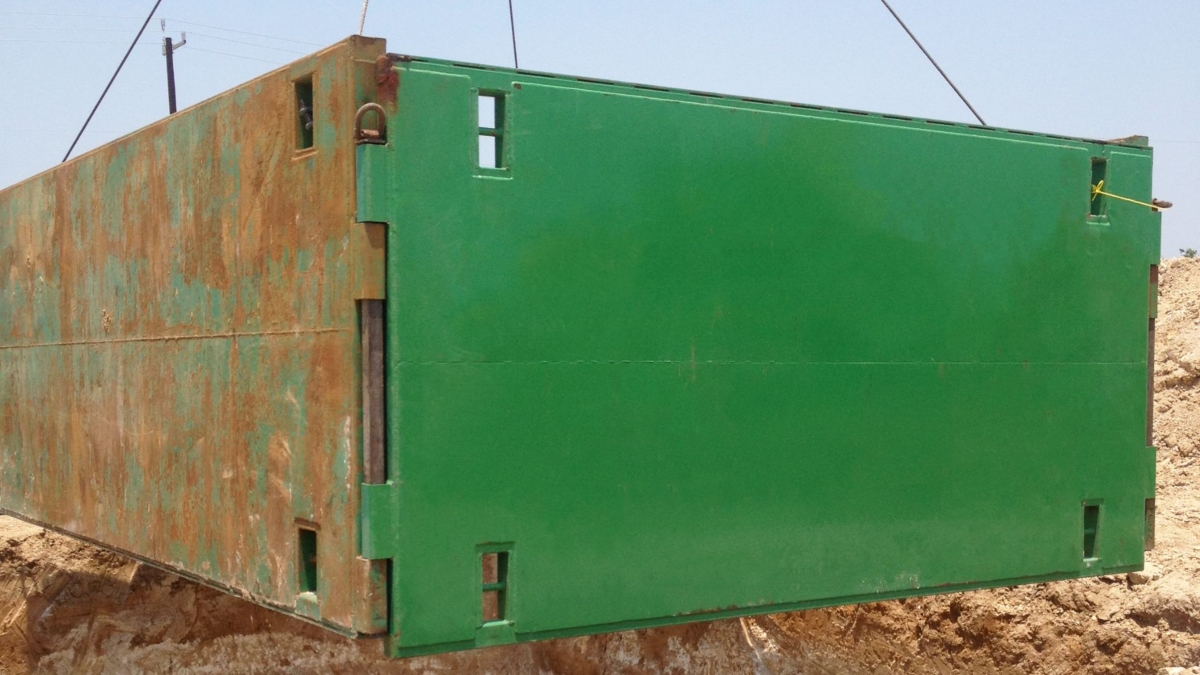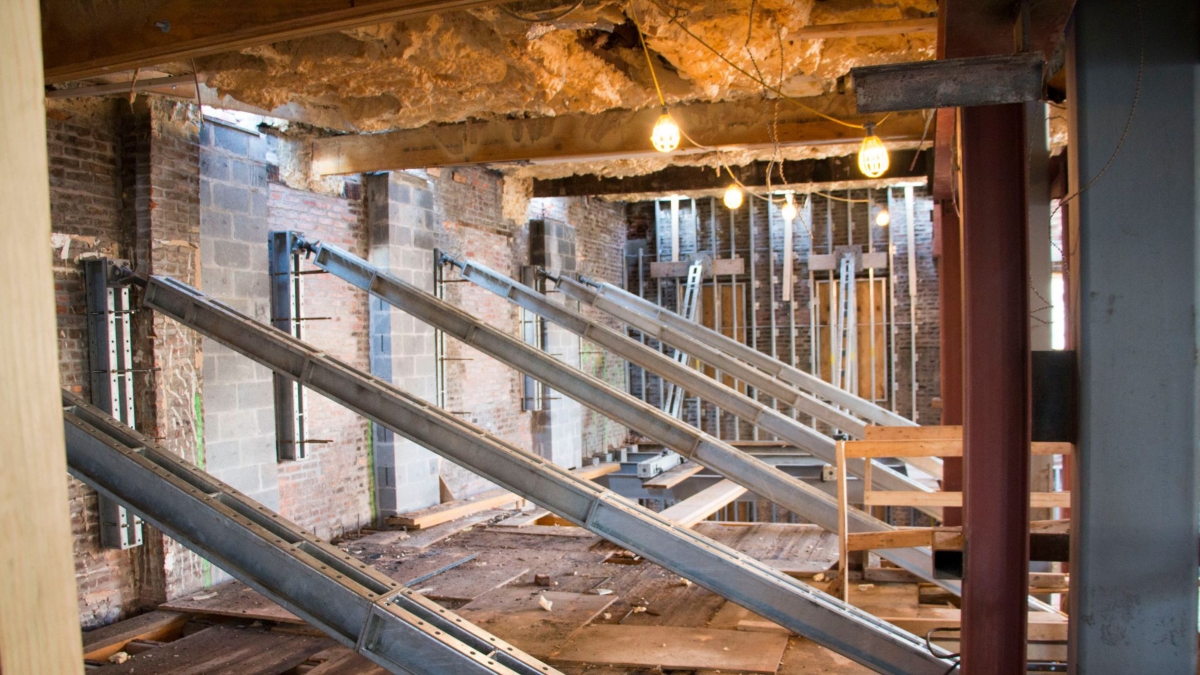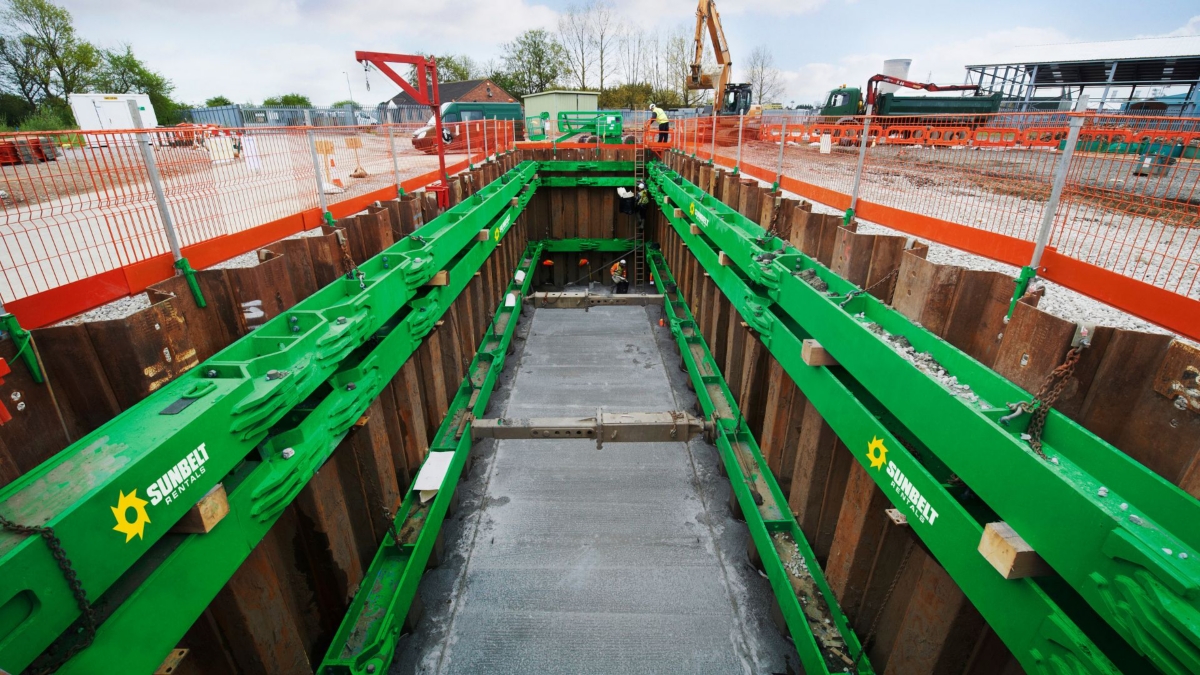Use the Sunbelt Rentals App
Find, rent, and return equipment, right at your fingertips
Employers must provide proper excavation safety training to their workers, including identifying potential hazards, using protective gear, and reacting in case of an emergency. This training should be reinforced by supplying adequate protective gear and equipment, like trench boxes, shoring, and sloping, to reduce the risk of cave-ins and collapses. However, every trench project is unique, and the most suitable shoring solution will vary for each project.
Types of Shoring Solutions
Confused about which shoring solution to choose? Click any of the links below to learn more:

The Purpose of Shoring
Trench shoring serves the crucial purpose of providing temporary support and protection to the walls of a trench or excavation to prevent collapses and ensure the safety of workers. Trenches are often dug for various construction, repair, or maintenance activities, such as installing pipelines, laying foundations, or repairing utilities. The primary objectives of trench shoring include:
- Preventing Cave-Ins: Trenches risk collapsing due to the pressure exerted by the surrounding soil. Trench shoring systems, including supports, shields, or other structural reinforcements, help prevent the walls from caving in and protect workers inside.
- Worker Safety: Trench collapses can be extremely dangerous and potentially fatal for workers. Trench shoring is essential to create a stable and secure working environment, reducing the risk of injuries or fatalities caused by soil movement.
- Compliance with Regulations: Many OSHA (Occupational Health and Safety Administration) regulations and guidelines mandate the use of protective measures, such as trench shoring, to ensure the well-being of workers during excavation activities. Compliance with these regulations is important for avoiding legal and financial consequences.
- Maintaining Excavation Shape: Trench shoring helps maintain the shape and stability of the trench, allowing workers to perform their tasks more efficiently. This is particularly important when precision is required for tasks like laying pipes or constructing foundations.
- Preventing Soil Movement: Besides preventing collapses, trench shoring also helps control soil movement around the trench. This is important for preventing damage to nearby structures, utilities, or infrastructure.

Excavation Shoring
Purpose: Excavation shoring is primarily used to support the sides of a trench or excavation to prevent collapses and protect workers. The primary goal is to ensure the safety of personnel working within the trench.
Application: This technique is commonly employed during activities like pipeline installation, foundation digging, or utility maintenance where a trench is dug into the ground.
Methods: Excavation shoring methods may include the use of trench boxes, hydraulic shoring systems, steel or aluminum trench shields, or other structural supports that are specifically designed to withstand the pressure exerted by the surrounding soil and prevent cave-ins.

Structural Shoring
Purpose: Structural shoring is employed to provide temporary support to existing structures during construction, renovation, or repair work. It helps prevent structural instability and collapse during modifications or when load-bearing elements are removed.
Application: Structural shoring is commonly used when working on buildings, bridges, or other structures where portions of the existing structure need support during alterations or repairs. It is often employed in situations where the structure's load-bearing capacity is temporarily compromised.
Methods: Structural shoring may involve the use of beams, posts, shores, or other temporary support structures that are strategically placed to bear the loads that would otherwise be supported by the parts of the structure that are being modified or replaced.
Soil Type and Classifications
OSHA provides clear guidelines on soil classifications that dictate the type of protective system required. Understanding soil types, such as cohesive or granular, is essential in determining the appropriate shoring solution.
- Stable Rock: This type of soil has no tendency to break apart or crumble. Excavations in stable rock generally do not require any support systems.
- Type A Soil: This soil type is the most stable and has the highest cohesion. It includes clay, silty clay, sandy clay, and clay loam. Type A soil is the most stable of the three classifications and is considered the safest for trenching. However, protective systems are still required for excavations deeper than 4 feet.
- Type B Soil: This soil includes angular gravel, silt, silt loam, and previously disturbed soils. It is less stable than Type A soil and may require additional safety measures, such as sloping, shoring, or shielding, for excavations deeper than 5 feet.
- Type C Soil: This soil type is the least stable and includes materials such as gravel, loamy sand, and submerged soil. Type C soil requires significant safety measures, such as sloping, shoring, or shielding, for excavations deeper than 5 feet.
How to Test for the Right Soil Type and Conditions
There are six critical questions that must always be addressed and answered before initiating any construction project that involves excavation work:
- Is the soil cohesive or non-cohesive?
- What is the water table's location?
- Will the soil remain stable long enough to install the shoring?
- What are the minimum clear access dimensions required inside the excavation?
- What are the potential consequences of deflection and ground movement?
- Is there a stable bottom to the excavation area?
Answering these questions will enable the estimator to arrive at a practical and cost-effective solution for the project. Sunbelt Rentals can assist to ensure your shoring solution aligns with OSHA standards.

Trench Walls (Sheet Piling)
Trench walls involve the use of interlocking steel, vinyl, or wood sheets, driven vertically into the ground to create a continuous barrier along the excavation perimeter. These walls prevent soil from collapsing into the trench and provide lateral support. Trench walls are effective in cohesive soils but may require additional measures like bracing or walers in granular soils.
Soldier Piles and Lagging
Soldier piles are vertical members, typically steel H-beams, spaced at regular intervals along the excavation perimeter. Wooden or steel lagging is placed horizontally between the soldier piles to retain the soil. Soldier pile and lagging systems are suitable for a wide range of soil conditions and are particularly effective in granular soils. Lagging is preferred in deep excavations and when large areas need to be protected.
Steel Beams (Horizontal Struts)
Steel beams, or horizontal struts, are installed horizontally between vertical supports, such as soldier piles or other shoring systems. They provide lateral support to the excavation walls and help distribute the load. Steel beams are often used in combination with soldier piles and lagging to enhance the overall stability of the excavation.
Hydraulic Shores
Hydraulic shores are a type of shoring system that uses hydraulic cylinders to provide support to trench walls. The hydraulic cylinders are typically attached to vertical members, such as steel or aluminum pipes, which are placed against the trench walls. They are then extended to press against the trench walls, providing lateral support and preventing soil collapse. These systems are versatile and can be easily adjusted to accommodate different trench dimensions. Common types of hydraulic shores include:
- Aluminum Hydraulic Shores: Lightweight and easy to handle, these shores are often used in smaller excavations.
- Steel Hydraulic Shores: Durable and suitable for a wide range of soil types and trench depths.
- Modular Hydraulic Shores: These systems consist of standardized, interchangeable components that can be assembled in various configurations to suit different trench geometries.
Trench Shields (or Trench Boxes)
Trench shields, also known as trench boxes, are prefabricated steel structures placed inside a trench to protect workers from cave-ins. They are typically large, box-like structures made of steel plates and are installed parallel to the excavation walls. Trench shields create a protective barrier, preventing soil from collapsing into the trench and providing a safe working environment. Some trench shields have adjustable components to accommodate different trench sizes. Common types of trench shields include:
- Aluminum Trench Boxes: Lightweight and corrosion-resistant, suitable for smaller excavations.
- Steel Trench Boxes: Tough and durable, used for larger excavations and in more challenging soil conditions.
- Slide Rail Systems: A type of trench support system that includes vertical rails and panels, allowing for a more flexible and adjustable configuration.
Choose the Correct Shoring Solution with Sunbelt Rentals
From small point repairs to large engineered systems, Sunbelt Rentals Trench Safety team is committed to ensuring the success and safety of your excavation project. Our state-of-the-art protective systems, site-specific engineered solutions, and industry-leading service are here to assist you from project inception to completion.
Trench Safety Resources
Dive deeper into Trench Safety with these related articles, blogs, and success stories.







